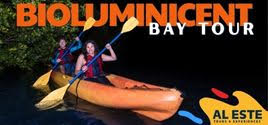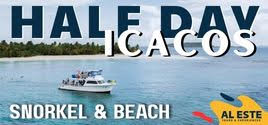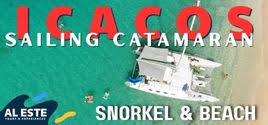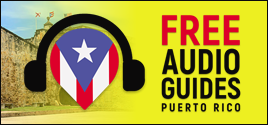PSA: How to Stay Safe in the Water
From our beaches, to rivers, to waterfalls, to canyons, and beyond, there are many extremely beautiful spots in Puerto Rico that are best experienced while being on or in the water. And many of the activities we write about take place in, on, or near bodies of water. With a little advance planning, all of those spots can be explored safely and without incident. The last thing you want to happen on vacation is the get banged up in the water, or swept out to sea, or worse. So spend a couple minutes reading this article so you are better prepared to have the best and safest vacation ever in Puerto Rico.
While the amazingly clear-blue water in Puerto Rico is so inviting, it is very important to “read” the water before jumping in. Rip currents are common at beaches all around the world, Puerto Rico included. The beautiful rivers here can turn deadly as the water rises rapidly during flash floods. Unfortunately, too many people drown, almost drown, or are severely hurt every year because they don’t know what to look out for. Entering the water without knowing if it is safe is just asking for trouble, and putting your own and other people’s lives (the lifeguard or the Good Samaritan who tries to rescue you) at risk. Here is a guide to help you know what to look for to avoid such disasters so you can enjoy Puerto Rico’s waters.

Risks at the Beach & in the Ocean
I know this may seem obvious to some, but it is really important to be able to swim if you are going to go in the ocean. Having a life jacket or some kind of flotation device attached to you will help. But even that is no substitute for being able to swim.
Never turn your back on the ocean. Large waves can pop up and either knock you over or pull you out into deep water quickly without you even being aware it was coming.
Never swim alone. Never leave kids unattended at the water’s edge, or playing even in shallow water.
Swim where there are life guards, and an pay attention to the safety flags. These safety flags are green (meaning that it is safe to go into the water), yellow (meaning warning, be careful), or red (meaning that it is not safe to swim, extreme danger). There may also be rip current warning signs. Stay alert, and stay alive.
The other BIG issue that so few people really are aware about are rip currents. Many of our beaches can develop rip currents, especially on the north coast. These usually happen during high surf conditions, and also during low tide, but they can form any time. These currents can happen anywhere depending on the waves, the underwater landscape, and beach layout. Before going to the beach, check for the daily rip current forecast post from the National Weather Service.

Did you notice the rip current in the photo above? I didn’t think so. We’ll point it out in the next photo.
Rip currents form when waves break strongly in one area, and less strongly in another. The water from the strong wave goes back to sea in the area where there is less resistance, so that’s where the waves are not as strong, or where there is nothing that will block the water’s immediate return to the deep.
Any break (above or below the water) in a reef, a shallow part of an sandbar, or rock formation will be a point where the water will rush out as rip currents. At the end of jetties or piers the currents will likely form. These currents are fast and strong and can pull someone (even strong swimmers) out to deep sea very quickly.
Unfortunately, there are many beaches in Puerto Rico where rip currents regularly occur. The very waves that make for great surfing and boogie boarding, can also be deadly. Beaches on the north, east and west coasts can be big problems, and a sadly number of people drown each year.
Jobos Beach in Isabela, many beach areas in the Piñones area in Loíza, and Candelario Beach at Palmas del Mar in Humacao have historically had the largest number of drownings. But the beaches in the San Juan area — Isla verde, Condado (especially La Concha), Ocean Park and Escambrón — also all have great rip current potential. Playa Caracoles and Poza del Obispo (both in Arecibo), Mar Chiquito in Manati, and Playa Escondida in Fajardo have perfect conditions for almost constant rip currents. Domes Beach in Rincón, and Playa Azul and La Pared in Luquillo also have rip currents regularly. And I have seen rip currents at beautiful Flamenco beach in Culebra, on the outer ends of the beach. Don’t assume the south coast is safe from these. Many beaches have warning signs out to watch for these currents. We have seen them especially in Guánica.
In short, don’t assume that any beach will be rip current free. The potential is always there. Knowing how to avoid getting into a rip current, and how to get out of one, is something anyone who goes into the ocean needs to know.

How to Spot a Rip Current
Rip currents are generally “calm looking” areas where the waves are not breaking. They look like a “safe” area to enter the water to swim, but they are not! You may notice a channel of churning, choppy water or an area where the churned up sand, foam, or debris is being pulled out to sea.
In the photo above, the rip current is indicated by the red arrow.
Do a search on Google for images of rip currents to see more, real-life photos, so you get a better idea of what to look for. But it may not look like that, or have any of the characteristic visible signs, so you need to know how to survive a rip current if you get caught in one.

How to Get Out of a Rip Current
Even though it goes against your body’s natural urge, you need to stay calm, and don’t fight it. Let the current take you out. You will be fine if you remain afloat, so float on your back, or slowly tread water. Don’t waste energy trying to fight the current, or swim directly back to shore. At some point, the current will dissipate, and you will be able to swim out of it to the side (parallel to the beach).
Once you are free of the current, swim parallel to the beach (in either direction away from the rip current), and then swim into the beach. See the green arrows in the photo above. If you need help getting back to shore, signal for help. Most importantly, remain calm so that you can stay afloat.
Here are some good resources on recognizing and understanding rip currents. We recommend taking a look at them …
- NWS/NOAA: How to Avoid Getting Caught in a Rip Current
- NWS/NOAA: Rip Current Science
- US Lifesaving Association: Ripcurrents

Risks Around Rivers, Streams, Waterfalls & Canyons
The big risks in these areas are flash floods, and submerged rocks.
Being that the middle of the island has a run of large mountains and rain forests, you will find many rivers, streams, waterfalls, canyons, and natural pools to play in. But as beautiful as they are, you need to be aware of the potential dangers and how to read the water.
We live on a slope of the mountain in El Yunque and at times, when it rains, it is harder and with such volume you really can’t believe it. We have seen 3″ of rain fall in minutes. It’s amazing! The sudden development of an intense local storm, high in the mountains can, increase the water level in rivers above flood stage in a matter of hours, if not minutes. And it rains a lot in the higher elevations, and for longer periods, than it does down at sea level. That’s what makes a rain forest, and keeps it so green.
One other interesting thing we noticed here is that you can hear the rain in the distance – heavy rain sounds like a freight train coming down the mountain. The sound is caused by the millions of large drops hitting the millions of leaves in the forest. We can hear it raining higher up in the mountain, while it is dry and sunny on our property. So don’t assume that if it is not raining where you are, it is safe to go in the river.

This much rain causes flash flooding of rivers. It may not be a big issue if you are at sea level, where you can quickly walk out of the water and onto high and dry land. Though we have seen rivers that can rise 30 feet during these flash flood, so make sure you know the way to safety at all time!.
But if you are up playing in a waterfall, steep river incline, or in a canyon, it can be deadly and it can be quick! One minute, you’re in knee-deep water getting that perfect Instagram shot, and the next minute it turns into a swift current and over-your-head water.

Watch the current! As rising river will get faster, and you will notice things floating down in it (like sticks and logs). Further down river it may also get reddish from the clay. If it starts to rain get out of the river. These rushing waters, and the stuff rushing down stream with the water, will make you lose your footing, and you will be pummeled against river rocks.
Be aware of what is upriver. There are a few places that have hydroelectric dams that, on occasion and without warming, will release their water. We have seen this happen while hiking in El Yunque off of south 191, on the Sabana River.
Some fast-running, deep rivers can have whirlpool zones around some submerged material that can trap someone. And as fun as it may seem to “take a shower” in a waterfall on you, stay away from the waterfalls – we have seen rocks and tree stumps come over them.
For a few days after heavy rainfall, be aware that currents can still be swift in rivers and streams, and you can get seriously hurt.

Another thing that people do in rivers, is jumping into water from heights. There are places like El Hippie, Tinajas, and almost any waterfall or charco that local kids jump and dive. It looks like great fun, but they hopefully know where the submerged rocks are. They sometimes know how shallow to jump. Or just how far to the right or left to land. Unfortunately, sometimes, they don’t. If you don’t know what is under the water, DON’T JUMP!
In Summary
Always consult the National Weather Service forecast before going into rivers!
We’ve written about personal safety in the past. Now is a good time to check out that article, also.
There are many opportunities to experience beautiful parts of Puerto Rico that involve being in or on the water. You should take advantage of those. Have fun. Be safe. Enjoy Puerto Rico’s waters. Don’t be stupid.

Puerto Rico Day Trips LLC assumes no responsibility regarding your safety when participating in the activities described in this article. Please use common sense! If your mother or that little voice in your head tells you that you are about to do something stupid … then don't do it!















